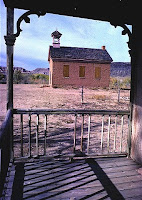Wild Wild West
 New Orleans' recovery czar is proposing seventeen recovery areas that will receive money for redevelopment/rebuilding.
New Orleans' recovery czar is proposing seventeen recovery areas that will receive money for redevelopment/rebuilding.
Dr. Edward Blakely, Executive Director of Recovery Management for the City of New Orleans, today announced the first 17 targeted recovery zones that will spur redevelopment and accelerate our recovery. The zones will be built around public assets in key business corridors in an effort to generate further private investment from developers. "These recovery zones represent a critical component of our rebuilding, "said Mayor C. Ray Nagin. "We will continue to leverage our limited resources to accelerate our recovery. Our citizens will benefit from the higher quality of life that will result."Dr. Blakely described the process as the wild wild west where pioneers put down stakes and people build around it.
Target areas are consistent with the development approaches citizens suggested in earlier redevelopment plans, such as the Unified New Orleans Plan, the Lambert Plan and the Bring New Orleans Back Commission plan. The city will provide loans and other incentives to developers interested in investing in key locations within the zones. The zones are generally high visibility sites, with sufficient land and other assets. They also have a high potential to attract investors and possess adequate resources to catalyze development such as schools and libraries.
"The development zones will spur activity from investors," said Blakely. "When one area starts to do well, investors will want to invest nearby. This will allow the city to redevelop wisely and will help residents make smart choices about where to rebuild.
The zones take three formats:
Rebuild areas have experienced severe destruction of physical structures and social networks. These areas will require major rebuilding, or significant public and private investment in order to recover.
Redevelop areas are places where some recovery components and resources are already present. They have a high potential for attracting investment and acting as a catalyst for further redevelopment and recovery of the affected community.
Renew areas include specific projects that require relatively modest public intervention in order to supplement work already underway by the private and nonprofit sector.
Each development zone is approximately one-half mile in diameter, although the area can vary slightly. The first zones are:
Rebuild
1. New Orleans East Plaza
2. Lower Ninth Ward
Redevelop
1. Carrollton Avenue at Interstate 10
2. Harrison Avenue (Canal Boulevard to City Park)
3. Gentilly Boulevard at Elysian Fields
4. St. Bernard/ AP Touro at North Claiborne Avenue
5. Broad Street at Lafitte Greenway/Treme
6. South Claiborne Avenue at Toledano
Renew
1. Canal Street (Downtown)
2. Broadmoor (R. Keller Center and Library)
3. Tulane Avenue at Jeff Davis (Comiskey Park)
4. O.C. Halley Corridor
5. Bayou Road/Broad Street Cultural Corridor (Market Building)
6. St. Roch Street (Market and neutral ground)
7. Freret Street (Farmers Market)
8. R.E. Lee at Paris Avenue (Lake Terrace Center improvements)
9. Alcee Fortier Street (Street Beautification)
In addition to the recovery areas, the City plans to invest in projects throughout New Orleans. These include park improvements, street and traffic signals and other programs designed to spur investment and enhance the quality of life.

No comments:
Post a Comment